From Idea to Reality: Developing a Strava-like App for Fitness Enthusiasts

Fitness apps have become a staple in the lives of millions worldwide. With the rise of personalized workouts that can be done at home, apps like Strava have gained immense popularity, leaving many wondering if it’s worth the investment to develop a successful fitness app like it. If you’ve found yourself googling this question, you’re not alone!
At Alternative-spaces, we understand the pain points of developing an app like Strava. In this complete guide, we’ll share our real-life experience and give you a step-by-step plan on how to make an app like Strava that stands out in the crowded fitness market. Keep it reading!
Table of contents
- Introduction to Strava and its success
- Why you should consider creating an app like Strava
- MVP features needed to create a successful app like Strava
- Alternative-spaces recommendations for creating a top-notch fitness tracking app like Strava
- How Strava makes money: Monetization models for your fitness app
- Alternative-spaces experience
- Final thoughts on creating a successful fitness-tracking app
- FAQ
Introduction to Strava and its success
Strava is a leading fitness app that has revolutionized the way people track and share their workouts. It provides users an easy-to-use platform for tracking running, biking, swimming, and other physical activities. With features such as leaderboards, challenges, training plans, and more, Strava has become one of the most popular apps among athletes of all levels.
Its popularity can be attributed to its focus on gamifying physical activity and providing users with tools to help them reach their goals.
Another reason for the popularity of fitness apps like Strava is the social aspect they offer. Strava provides a social network for athletes. It allows users to connect with friends, join groups, and participate in challenges. Users can follow other athletes, view and comment on each other’s activities, and share their progress on social media platforms.
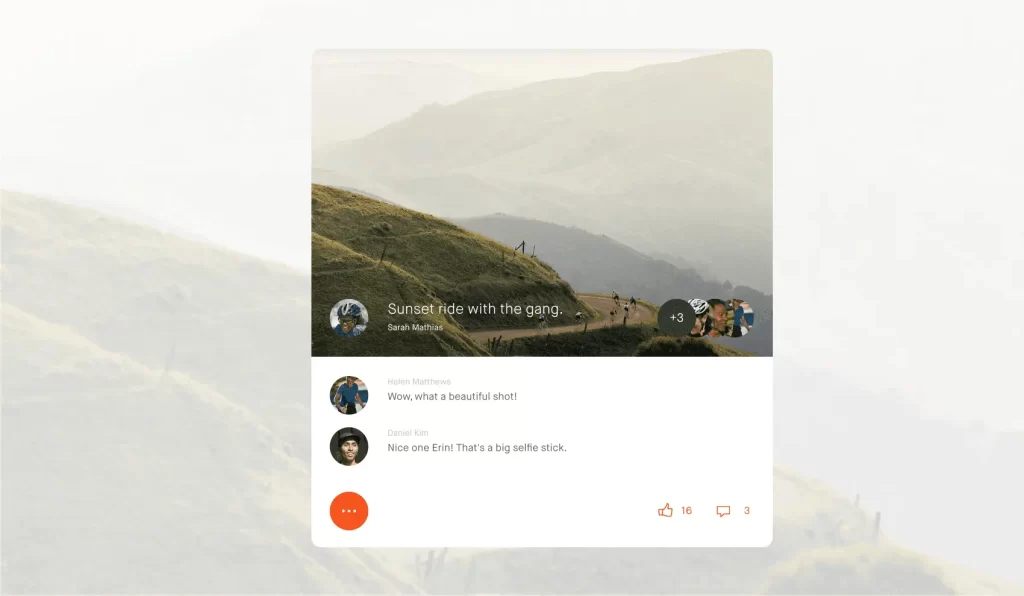
By leveraging data from millions of global users, Strava has created an engaging experience that encourages users to keep active while having fun at the same time.
This combination has been key to its success in becoming one of the top fitness apps in the world today.
Why you should consider creating an app like Strava
Building apps similar to Strava is a great way to enter the fitness industry and take advantage of the increasing demand for health-focused apps. With its wide range of features, Strava has become one of the most popular fitness platforms available today, and by creating a similar app, you can tap into this growing market and cater to a larger audience.
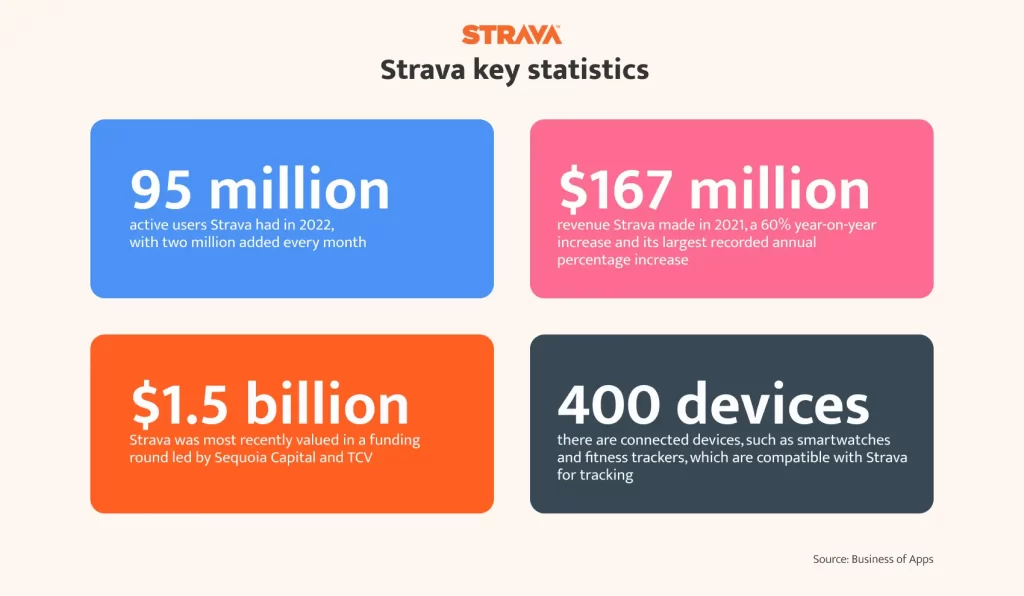
Here are some benefits of app development like Strava:
Growing fitness market
The global fitness app market has experienced significant growth in recent years and is expected to continue expanding at a rapid pace. Key factors driving the market growth include the rising focus on health and fitness, the increasing prevalence of chronic diseases, growing fitness trends, and the convenience and flexibility of fitness apps.
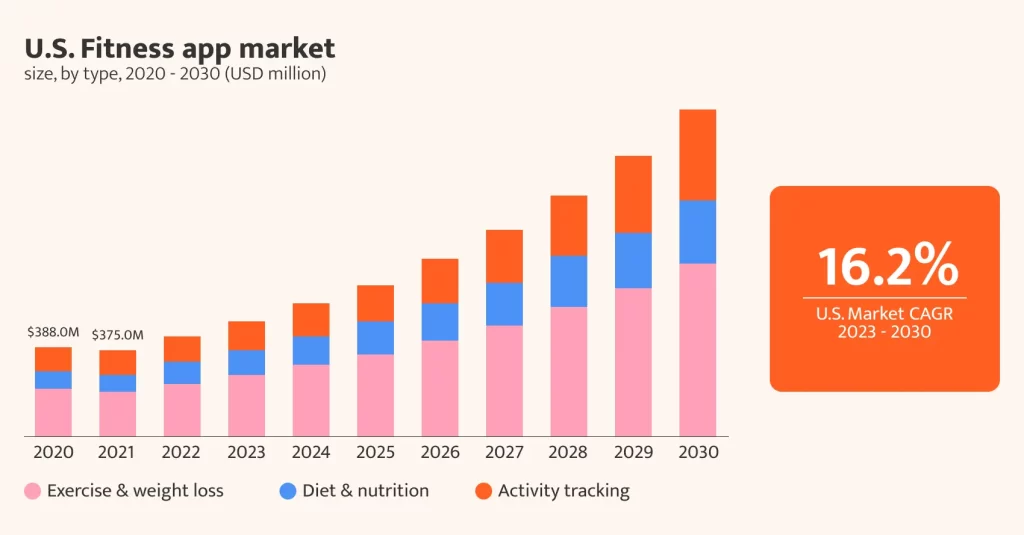
People are becoming increasingly health conscious
With the rise of chronic diseases related to poor lifestyle habits like unhealthy eating and lack of physical activity, people are realizing the importance of taking care of their health. The growing interest in fitness, wellness, and healthy living has increased demand for health and fitness apps like Strava. These apps provide users with an easy and convenient way to track their progress, set goals, and stay motivated to maintain a healthy lifestyle.
Revenue potential
Developing a successful fitness app opens up various monetization avenues, including subscription models, in-app purchases, partnerships with fitness brands or trainers, and targeted advertising. With the right strategies, you can generate revenue and build a sustainable business.
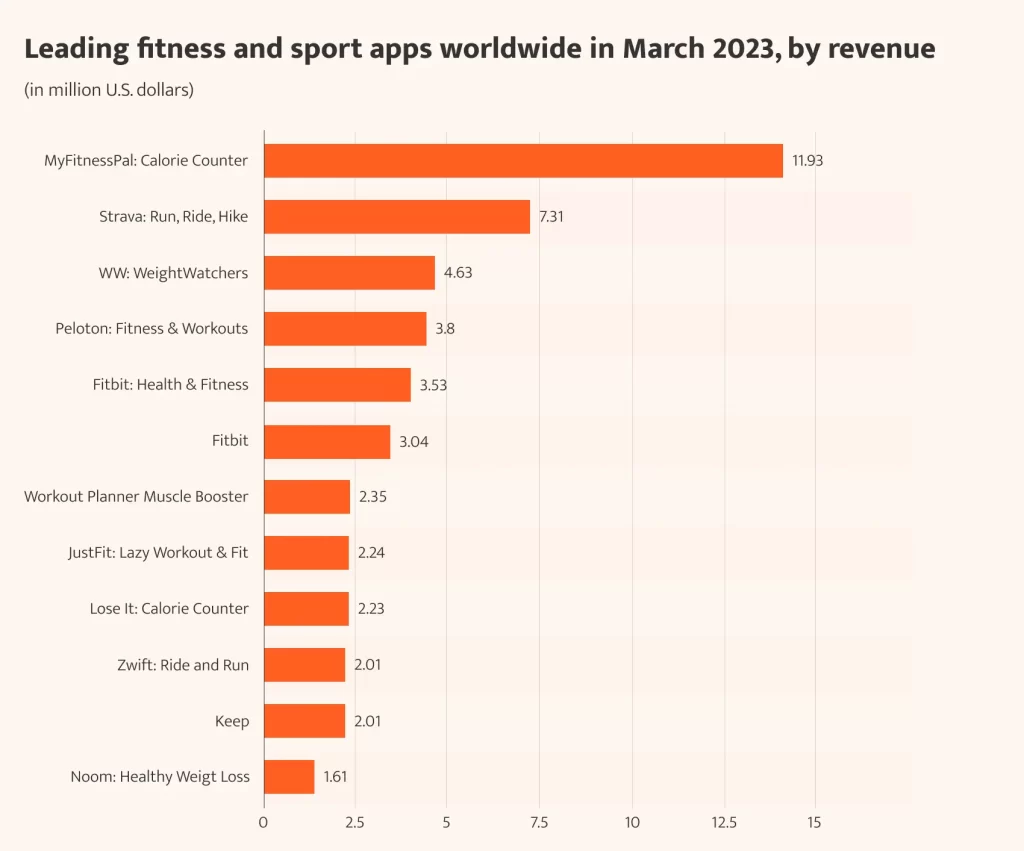
Brand awareness
Developing an app like Strava can increase brand visibility and awareness. By creating an engaging and useful app, businesses can attract and retain users, who may become loyal customers.
Customer engagement
Apps like Strava offer a unique way for businesses to engage with their customers. By providing users with an interactive platform, companies can build more meaningful customer relationships, increasing loyalty and brand advocacy.
Innovation and differentiation
Building an app like Strava allows you to innovate and differentiate yourself in the market. You can introduce unique features, incorporate emerging technologies like AI or virtual reality, or focus on specific niche segments to cater to underserved user needs.
MVP features needed to create a successful app like Strava
The focus of an MVP is on delivering the core features and functionality essential for solving a specific problem or addressing a particular need. With an MVP, businesses can test the market and validate their assumptions about what users want and need while reducing risk and optimizing cost.
Read also: How to Build an MVP for a Fitness Application
We’ve prepared a list of some MVP features that should be included in the development of a custom fitness app like Strava:
User registration and profile
Allow users to create accounts, set up profiles, and manage personal information. This feature enables personalized experiences and tracks individual progress.
Workout tracking
The ability to track workouts is a core feature of any fitness app, including Strava. This should include monitoring key metrics such as distance, time, and calories burned.
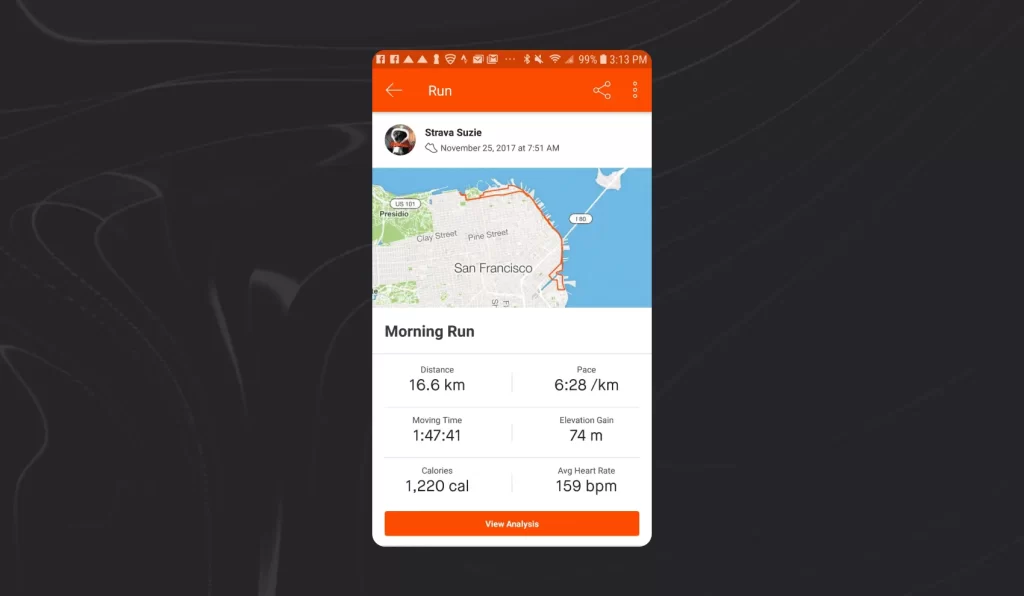
Goal setting
This feature allows users to customize their goals based on their preferences and abilities. They can create goals for individual workouts, weekly targets, or longer-term objectives. The app may also provide recommendations or guidance on setting realistic and attainable goals, ensuring users don’t overexert themselves or set unrealistic expectations.
Nutrition tracking
The nutrition tracking feature is an essential component of a successful fitness app. It allows users to monitor and manage their dietary intake, helping them make informed decisions about their nutrition and achieve their health and fitness goals. With this feature, users can easily log their meals and track their calorie intake, macronutrients (such as carbohydrates, proteins, and fats), vitamins, and minerals.
Route mapping
With the route mapping feature, users view their routes in real-time as they progress through their workouts. The app displays the route overlay on a map, typically using satellite imagery or a combination of map layers. This visual representation gives users a better understanding of their workout’s geographical context and allows them to see landmarks, terrain variations, and other points of interest.

Challenges
This feature enables users to participate in various challenges or competitions. These challenges encourage users to push themselves, track their progress, and achieve milestones.
Notifications
Implement push notifications to inform users about achievements, challenges, friend activities, or reminders to stay active. Timely notifications help maintain user engagement and drive participation.
Performance analytics
Provide users with detailed analytics and insights on their workout data. This includes average pace, elevation gain, heart rate, and progress over time. Visualizing progress and improvement is crucial for user engagement and motivation.

Social feed
Create a social feed where users can view and interact with their friends’ activities, leave comments, give kudos, and engage in friendly competition. This feature enhances the sense of community and encourages social interaction.
Read also: How to Implement AR in a Fitness App
Third-party integrations
By incorporating third-party integrations, you can offer a more comprehensive and seamless experience. Examples include integrating wearable devices to track heart rate or offering nutrition tracking through partnerships with food logging apps. It broadens your app’s capabilities and enhances the overall value proposition for users.
When selecting third-party integrations, it’s essential to consider the compatibility, reliability, and security aspects to ensure a smooth and secure user experience.
Ensure that you incorporate these key features of an app like Strava, as they form the foundation of a robust and functional fitness app.
Alternative-spaces recommendations for creating a top-notch fitness tracking app like Strava
Well, how to create an app like Strava? This process requires careful consideration of several important factors to ensure its success. Here are a few key factors to consider:
Conduct thorough research
Conducting research before building an app like Strava has significant benefits, including understanding user needs, identifying market opportunities, saving time and money, improving the user experience, and increasing app success.
Here are some steps you should take to conduct adequate research:
- Identify user needs. Determine the needs of your target audience, focus groups, and interviews. This will help you understand your users and their preferences, pain points, and motivations regarding fitness tracking.
- Analyze competitors. Conduct a competitive analysis to identify the strengths and weaknesses of existing fitness tracking apps. This will help you identify gaps in the market and determine how you can differentiate your app from others.
- Define critical features. Based on user needs and competitor analysis, define your app’s key features and functionality. This will help you prioritize development efforts and ensure that your app meets the needs of your target audience.
- Develop a prototype. Build a prototype to test your app’s design, usability, and functionality. This will help you identify potential issues early on and make necessary changes before launching the app.
Read also: How to Move From Idea to Prototype [A Step-By-Step Guide]
Before diving into coding and design, it’s crucial to establish a solid foundation for building a great product. This involves understanding your users’ needs and ensuring that your product’s functionality meets them. This is where a discovery phase can be immensely helpful.
For example, at Alternative-spaces, we provide software product discovery services to bridge the gap between the business concept of your software project and its technical realization. In just 2-4 weeks, we’ll finalize your product vision, build a clickable prototype, work out the product architecture, and provide a cost proposal with time estimates.
Focus on user experience
Providing a great user experience when designing a fitness app is critical for driving user engagement, satisfaction, goal attainment, app adoption, and differentiation from competitors.
Our experts know how to make an app like Strava, so below they share some practical tips that will help you to ensure your app offers a positive and engaging user experience:
- Focus on usability. Keep the app simple and intuitive to use. Utilize clear labeling, intuitive navigation menus, and visual cues to guide users through the app. Avoid cluttered screens or overwhelming users with too many options.
For example, Strava offers a clean and intuitive interface allowing users to track and analyze their workouts easily. It provides detailed data such as distance, pace, elevation, and heart rate, presented visually appealing and informatively.

- Utilize visual design. Use a design style that is visually appealing, modern, and reflective of your brand. Select a color scheme, typography, and visual elements that improve the aesthetic appeal of the app.
- Offer personalization. To make the app more engaging and relevant, offer personalization features such as goal tracking, workout plans, and dietary recommendations.
- Utilize wearable technology. Integrate wearable technology such as fitness trackers or smartwatches to enhance the user experience and provide users with more detailed data about their workouts.
For example, Strava integrates with various popular fitness tracking devices such as Garmin, Fitbit, Polar, and Apple Watch. By connecting these devices to the app, users can track their workouts, receive real-time feedback, and receive detailed performance metrics such as heart rate, speed, distance, and elevation. This integration with wearable technology helps improve the accuracy of the data recorded by the app and provides users with more detailed insights into their workouts.

Safety must come first
It’s crucial to prioritize data security and privacy when developing your app. Uphold strict data protection practices to ensure users’ private information and fitness data are safeguarded. Comply with relevant data protection laws and regulations, and communicate your privacy policies transparently to establish user confidence.
Here are some key steps that you can take to build a secure fitness app:
- Authorization and authentication. Implement strong authorization and authentication mechanisms to ensure only authorized users can access the app’s features and data.
- Secure data storage. Ensure all user data is stored securely using encryption and other security measures to prevent unauthorized access.
- Data minimization. Collect only the necessary data for the app’s functionality, and minimize the data collected to reduce the risk of data breaches.
- Regular security audits. Conduct regular security audits to identify and address vulnerabilities before attackers can exploit them.
- User privacy. Ensure that the app’s privacy policy is clear and transparent and that users have control over their personal data. Obtain explicit consent from users before collecting or sharing any sensitive data.
- Compliance with regulations. Comply with relevant regulations such as GDPR, HIPAA, and CCPA to ensure that user data is handled in accordance with legal requirements.
Gamification, social, and community features
Implement gamification elements like badges, rewards, and challenges to enhance user engagement and motivation. Additionally, incorporate social features like leaderboards, comments, and the ability to connect and interact with other users to foster a sense of community.
All these can help increase user motivation by providing a tangible sense of progress and achievement, create a sense of community among users, and enhance the user experience by making the app more interactive, personalized, and enjoyable.
Integrating with third-party services
Integrating with third-party services allows you to offer more functionality to your users without having to build it yourself. This can save you time and resources while providing users with more options.
For example, integration with popular wearable devices such as fitness trackers, smartwatches, or heart rate monitors allows you to collect real-time biometric data directly from the user’s device. Or by leveraging location-based services like Google Maps or Apple Maps, fitness apps can provide accurate mapping, route planning, and navigation functionalities. Integrating with popular music streaming services like Spotify or Apple Music allows users to access their playlists directly within the fitness app.
Also, you can ensure integration with health and nutrition apps enabling users to synchronize their fitness data with other platforms. For example, linking with a calorie-tracking app can give users a comprehensive overview of their daily caloric intake and expenditure, promoting a balanced approach to health and fitness.
Careful consideration of these factors can increase the chances of developing a successful app like Strava. By understanding user needs, delivering a unique value proposition, providing an engaging user experience, and incorporating the right features, businesses can build an app that caters to the growing demand for fitness tracking and community engagement.
If you need even more information about how to build a fitness app and fitness app development cost, you might want to check out this article: What it Takes to Make a Custom Fitness App: 2023 Complete Guide.
How Strava makes money: Monetization models for your fitness app
Monetizing a fitness app like Strava requires careful consideration of revenue models that align with the app’s value proposition and user base. In 2021, Strava recorded its largest annual percentage increase with a 60% rise in revenue, resulting in a total revenue of $167 million.
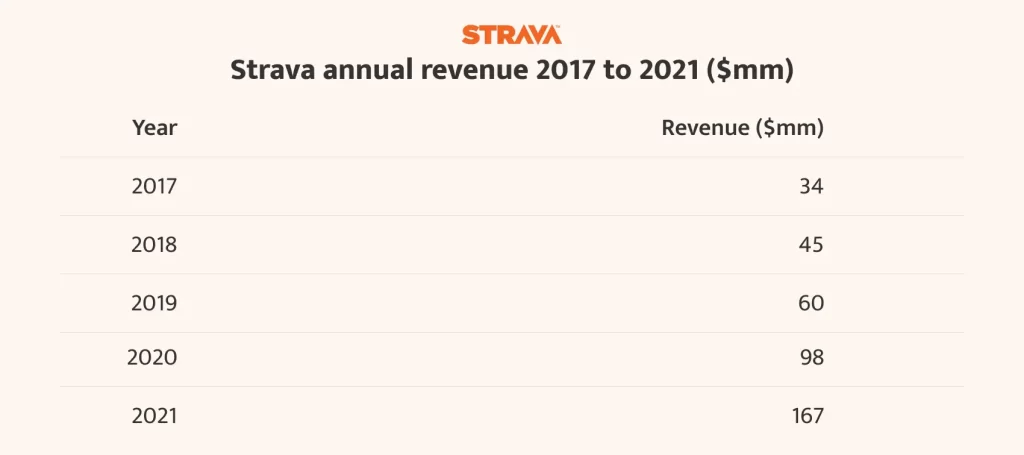
So, a question arises “How does Strava make money?” Here are some common monetization strategies for fitness apps:
Subscriptions
Implement a subscription-based pricing structure, where users pay a recurring fee (monthly, quarterly, or annually) to access all features and services of the app. While Strava offers a free version of their app, they also have a paid subscription service that provides additional benefits not available in the free version. These benefits include route planning, goal setting, a training log with a training dashboard, and more. However, users must pay a monthly fee to access these premium features.
Subscription: $2.50 /mo* after 30 days
In-app purchases
Offer in-app purchases for digital goods or premium content. This can include additional workout plans, virtual coaching sessions, advanced analytics, or exclusive challenges. Users can choose to make one-time purchases or unlock specific features through microtransactions.
Sponsored challenges
Strava also generates income through Sponsored Challenges on its operations’ B2B (business to business) side. Sponsored Challenges usually run for a few days up to a month, allowing brands to promote their products or services to a new audience while keeping their existing customers engaged with their brand.
Brands interested in this option can purchase challenges starting at $20,000, with the highest tier reaching approximately $200,000.
Strava has partnered with many notable companies, including Reebok, Peloton, Red Bull, and others.
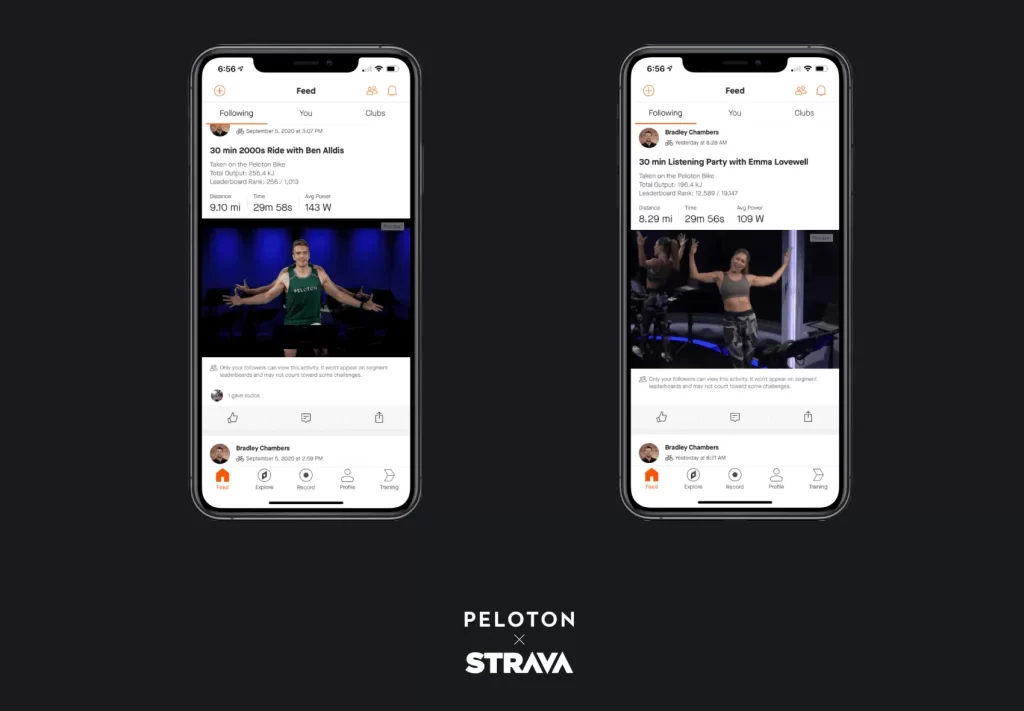
Data sales
With user consent and adherence to privacy regulations, anonymized and aggregated user data can be leveraged to generate insights or sold to research organizations, fitness-related companies, or insurance providers.
Strava introduced its Metro product in 2014, aimed at providing data from its platform to urban planners, municipalities, and other customers. The company charges a fee of approximately $20,000 per year for access to this data. Customers can then use this data to make informed decisions about planning initiatives such as constructing bikes or running lanes.
It’s important to note that Strava does not sell personal user data to these customers. Instead, the company distributes anonymized and aggregated data.
Sponsorship and partnerships
Collaborate with fitness brands, sports equipment manufacturers, or wellness companies for sponsorship opportunities. This can involve promoting their products or services within the app, featuring sponsored challenges, or offering exclusive discounts to app users.
For example, Strava has partnered with hotel chains and bike-sharing companies to offer exclusive discounts to its users.
It’s important to select a monetization model that aligns with the app’s target audience, value proposition, and competitive landscape is important. A combination of revenue streams can also be implemented to diversify income sources. Regular evaluation of user feedback, market trends, and revenue performance will help optimize the monetization strategy and ensure a sustainable business model for the fitness app.
Alternative-spaces experience
Whether you need an app for tracking fitness progress, monitoring sports performance, or want a custom solution for your sports or fitness business, Alternative-spaces is the reliable technology partner you can count on for success. With over 22 years of experience, we have a proven track record of helping businesses in various industries to develop, scale, enhance, and support unique technology solutions.
With our extensive expertise, we know how to create an app like Strava. We offer a wide range of custom software development services for the sports and fitness industry:
- Wearable apps development
- Fitness mobile apps
- Sports apps UI/UX design
- Coaching apps
- Sports streaming apps
- Sports event booking apps
The Alternative-spaces team has a lot of experience in creating user-friendly and intuitive fitness web and mobile applications. For example, recently, we’ve developed Clubhouse, an online fitness class platform providing access to top-notch virtual fitness classes and workout videos.
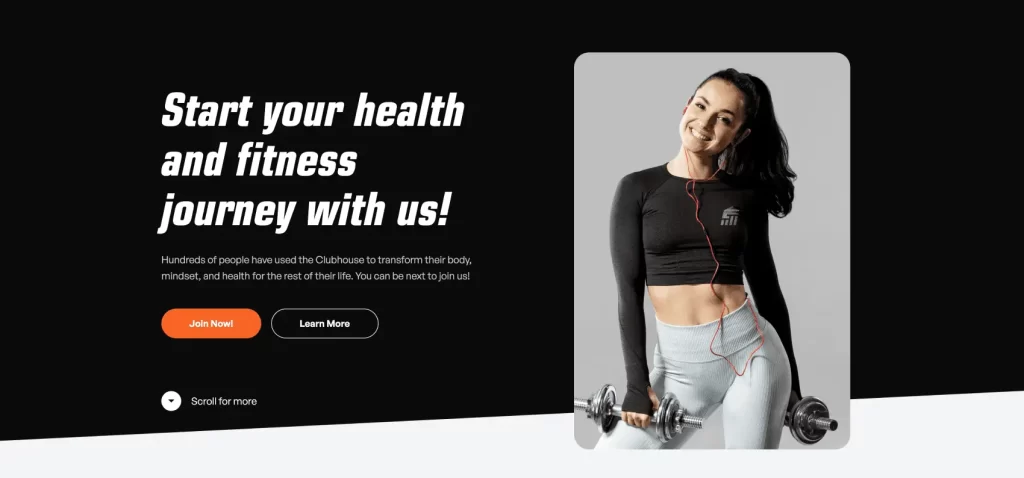
We also have experience building mobile apps integrated with wearable devices. Phlex is a simple tool that enables swimmers to connect their wearable devices with a mobile app and collect motion data for accurately tracking their swimming. Using unique devices with motion data analysis, Phlex analyzes the user’s motions during training and, based on that, provides precise data about users’ swimming technique and performance.

One more example of our work is James Smith Academy. It’s a personal online trainer that provides users with personalized training and nutrition programs tailored to their specific requests.

Our team of app development experts is equipped to create custom solutions that align with your specific objectives and requirements!
Final thoughts on creating a successful fitness-tracking app
Creating a successful fitness app like Strava is no small feat, but with the right development team and strategy in place, you can make it happen. From building features that encourage user engagement to finding ways to monetize your app, there are many areas of focus when developing an app like Strava.
With careful planning and execution, you can create a great product that stands out from its competitors.
If you need help creating your own custom fitness app similar to Strava, contact us today!
FAQ
- Why is partnering with Alternative-spaces a smart option for developing fitness apps like Strava?
Partnering with Alternative-spaces to develop fitness apps like Strava can be a smart option for several reasons:
– Experience in developing fitness apps: Alternative-spaces has experience in developing fitness apps and can bring that expertise to your project. We’ve worked on projects ranging from workout tracking and nutrition to wearable devices and help you build an app that meets the needs of your users.
– Customized solutions: We provide customized solutions to meet your unique requirements. Our specialists work with you to develop a customized architecture, user interface, and features that are specific to your app’s needs.
– Expertise in cloud technology: We help ensure that your app is built on a scalable and secure cloud infrastructure. This will result in a more reliable and robust app that can handle high levels of user traffic and usage levels.
– Integration with third-party tools: The Alternative-spaces team helps you to integrate your app with third-party tools such as wearable devices, fitness trackers, and other applications. This improves the user experience and increases user engagement.
– Quality assurance: We provide quality assurance services to ensure that your app is free of bugs, errors, and security vulnerabilities. This can help prevent issues that could harm your users’ experience with your app.
- How much does it cost to develop an app like Strava?
The cost of developing an app like Strava can vary depending on various factors such as the complexity of features, platform (iOS, Android, or both), design requirements, development team rates, and more. It’s challenging to provide an exact cost without detailed project specifications. We recommend you consult with our experts to get a more accurate estimate based on your specific requirements.
- What are the benefits of hiring offshore fitness app developers?
Hiring offshore fitness app developers can offer significant benefits in terms of cost savings, access to a larger talent pool, flexibility, faster development time, expertise in specific technologies, and a focus on core business functions. By choosing the right offshore development partner, businesses can create high-quality fitness apps that meet the needs of their users and drive growth and success.
- How long does it take to build a Strava-type app?
Building a Strava-type app can take several months to a year or more. The development time can vary widely depending on several factors, such as the app’s complexity, the features and functionality included, the development team’s experience and expertise, and the project management approach used.
It’s important to work with a skilled and experienced development team and have a clear project plan and timeline to ensure that the project stays on track and meets its objectives.
- What are the best and most unique features an app like Strava can have?
Strava is a popular fitness app with several unique features that set it apart from other fitness apps. Here are some of the best and most unique features that an app like Strava can have:
- Personalized training plans: Strava offers personalized training plans for various activities such as running, cycling, and swimming. These training plans are tailored to the user’s fitness level, goals, and schedule.
- Segments: Strava’s segment feature allows users to track their performance on specific routes or sections of their workouts. This gives users a sense of achievement and helps them track their progress over time.
- Heatmaps: Strava’s global heatmap shows popular routes and workout locations around the world, helping users discover new places to explore or train.
- Virtual races: Strava allows users to participate in virtual races against other users, providing a sense of competition and motivation.
- Safety features: Strava has built-in safety features such as Beacon, which allows users to share their real-time location with friends and family during a workout.
- Social sharing: Strava’s social sharing features allow users to connect with other users, join clubs, and share their workouts and achievements on social media platforms.
Content created by our partner, Onix-systems.
Source: https://onix-systems.com/blog/how-to-develop-an-app-like-strava Home
Home